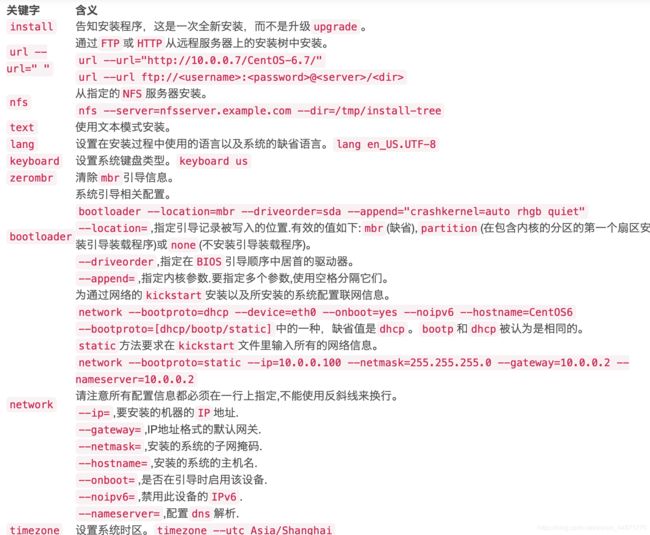pxe+kickstart+dhcp+tftp+httpd实现无人值守安装CentOS7系统
下面是小凰凰的简介,看下吧!
人生态度:珍惜时间,渴望学习,热爱音乐,把握命运,享受生活
学习技能:网络 -> 云计算运维 -> python全栈( 当前正在学习中)
您的点赞、收藏、关注是对博主创作的最大鼓励,在此谢过!
有相关技能问题可以写在下方评论区,我们一起学习,一起进步。
后期会不断更新python全栈学习笔记,秉着质量博文为原则,写好每一篇博文。
文章目录
- 一、简介
- 1、什么是PXE
- 2、PXE的工作过程
- 二、实现网络手工安装
- 1、系统环境准备
- 2、安装配置dhcp服务
- 3、安装配置tftp服务
- 4、安装配置httpd服务
- 5、配置PXE启动程序
- (1)PXE引导配置
- (2)PXE配置文件default解析
- 6、测试手工网络安装操作系统
- (1)新建空白虚拟机
- (2)启动虚拟机
- 三、实现kickstart自动化安装
- 1、ks.cfg详解
- 2、编写ks.cfg文件
- 3、开机优化脚本
- 4、整合编辑default配置文件
- 5、无人值守自动安装
一、简介
1、什么是PXE
- PXE,全名Pre-boot Execution Environment,预启动执行环境
- PXE客户端(client)这个术语是指机器在PXE启动过程中的角色。一个PXE客户端可以是一台服务器、笔记本电脑或者其他装有PXE启动代码的机器(我们电脑的网卡)。
2、PXE的工作过程
 推荐看下:
推荐看下:
 注意:
注意:
1. 后面实操应该实时查看系统日志,结合这个图进行分析理解!
2. 上面不论是dhcp还是其他服务我们都部署在一个虚拟机上!
二、实现网络手工安装
1、系统环境准备
目的:实现为数百台空白服务器,安装操作系统!
# 关闭防火墙
systemctl stop firewalld
# 关闭selinux
sed -i '/SELINUX/s/enforcing/disabled/g' /etc/selinux/config # 重启
getenforce
# 虚拟机网卡说明
本机需要两块网卡,一块网卡为NAT模式,一块网卡为LAN区段
配置yum源:
cd /etc/yum.repos.d/
rm -f *
mount /dev/sr0 /mnt
vim /etc/yum.repos.d/base.repo
'
name=base
baseurl=file:///mnt/
gpgcheck=0
enabled=1
'
2、安装配置dhcp服务
// 本机的内网网卡ip为192.168.1.201
yum install dhcp -y
[root@linux-node1 ~]# vim /etc/dhcp/dhcpd.conf
subnet 192.168.1.0 netmask 255.255.255.0 {
range 192.168.1.1 192.168.1.200;
option subnet-mask 255.255.255.0;
default-lease-time 21600;
max-lease-time 43200;
next-server 192.168.1.201;
filename "/pxelinux.0";
}
// 注:dhcp服务器应该和需要安装操作系统的虚拟机在一个内网环境中,且没有其他dhcp服务器的干扰!
systemctl restart dhcpd
3、安装配置tftp服务
yum install tftp-server -y
[root@linux-node1 ~]# vim /etc/xinetd.d/tftp
service tftp
{
socket_type = dgram
protocol = udp
wait = yes
user = root
server = /usr/sbin/in.tftpd
server_args = -s /var/lib/tftpboot // 指定目录,保持默认,不用修改
disable = no // 由原来的yes改为no
per_source = 11
cps = 100 2
flags = IPv4
}
systemctl start tftp.socket
systemctl start tftp.service
netstat -luntp|egrep '69|67'
4、安装配置httpd服务
yum install httpd -y
sed -i '96i ServerName 127.0.0.1:80' /etc/httpd/conf/httpd.conf
systemctl restart httpd
mkdir /var/www/html/CentOS-7.6
cp -a /mnt/* /var/www/html/CentOS-7.6/
# 注意还有两个隐藏文件没有拷贝过去:
cp /mnt/.discinfo /var/www/html/CentOS-7.6/
cp /mnt/.treeinfo /var/www/html/CentOS-7.6/
# 前面将centos7的镜像文件挂载到了/mnt下,我们需要把镜像文件复制到httpd的发布目录来,后面虚拟机回自己找httpd来下载
curl http://192.168.1.201/CentOS-7.6/ # 看下httpd是否成功!
5、配置PXE启动程序
(1)PXE引导配置
syslinux是一个功能强大的引导加载程序,而且兼容各种介质。SYSLINUX是一个小型的Linux操作系统,它的目的是简化首次安装Linux的时间,并建立修护或其它特殊用途的启动盘。如果没有找到pxelinux.0这个文件,可以安装一下。
yum install syslinux -y
cp /usr/share/syslinux/pxelinux.0 /var/lib/tftpboot/
cp -a /var/www/html/CentOS-6.7/isolinux/* /var/lib/tftpboot/
mkdir -p /var/lib/tftpboot/pxelinux.cfg
cp /var/www/html/CentOS-6.7/isolinux/isolinux.cfg /var/lib/tftpboot/pxelinux.cfg/default
(2)PXE配置文件default解析
[root@linux-node1 ~]# vim /var/lib/tftpboot/pxelinux.cfg/default
label linux
menu label ^Install CentOS 7
kernel vmlinuz
append initrd=initrd.img inst.stage2=http://192.168.1.201/CentOS-7.6/ quiet net.ifnames=0 biosdevname=0
// 其中"net.ifnames=0 biosdevname=0"这两个内核启动参数是为了让网卡名称为ethN,而不是默认的eno16777728这样的随机名称。
6、测试手工网络安装操作系统
因为我电脑是mac本,这里听说本机的内网网卡需要用lan区段,但是我这个vmware fusion好像并没有这个网络模式,因此我采用了仅主机模式,但是到这里出现了问题!这个只能等以后有机会了,再补充完善吧!
(1)新建空白虚拟机
(2)启动虚拟机
三、实现kickstart自动化安装
1、ks.cfg详解
ks.cfg文件组成大致分为3段
- 命令段
键盘类型,语言,安装方式等系统的配置,有必选项和可选项,如果缺少某项必选项,安装时会中断并提示用户选择此项的选项
- 软件包段
- %packages
- @groupname:指定安装的包组
- package_name:指定安装的包
- -package_name:指定不安装的包
在安装过程中默认安装的软件包,安装软件时会自动分析依赖关系。
- 脚本段(可选)
1. %pre:安装系统前执行的命令或脚本(由于只依赖于启动镜像,支持的命令很少)
2. %post:安装系统后执行的命令或脚本(基本支持所有命令)
2、编写ks.cfg文件
# 先生成一个密码备用
[root@linux-node1 ~]# grub-crypt
Password:123456
Retype password:123456
$6$X20eRtuZhkHznTb4$dK0BJByOSAWSDD8jccLVFz0CscijS9ldMWwpoCw/ZEjYw2BTQYGWlgKsn945fFTjRC658UXjuocwJbAjVI5D6/
[root@linux-node1 ~]# mkdir /var/www/html/ks_config
[root@linux-node1 ~]# vim /var/www/html/ks_config/CentOS-7.6-ks.cfg
# Kickstart Configurator for CentOS 7.6 by yao zhang
install
url --url="http://192.168.1.201/CentOS-7.6/"
text
lang en_US.UTF-8
keyboard us
zerombr
bootloader --location=mbr --driveorder=sda --append="crashkernel=auto rhgb quiet"
network --bootproto=dhcp --device=eth0 --onboot=yes --noipv6 --hostname=CentOS7
timezone --utc Asia/Shanghai
authconfig --enableshadow --passalgo=sha512
rootpw --iscrypted $6$X20eRtuZhkHznTb4$dK0BJByOSAWSDD8jccLVFz0CscijS9ldMWwpoCw/ZEjYw2BTQYGWlgKsn945fFTjRC658UXjuocwJbAjVI5D6/
clearpart --all --initlabel
part /boot --fstype=ext4 --asprimary --size=200
part swap --size=1024
part / --fstype=ext4 --grow --asprimary --size=200
firstboot --disable
selinux --disabled
firewall --disabled
logging --level=info
reboot
%packages
@base
@compat-libraries
@debugging
@development
tree
nmap
sysstat
lrzsz
dos2unix
telnet
%post
wget -O /tmp/optimization.sh http://192.168.1.201/ks_config/optimization.sh &>/dev/null
/bin/sh /tmp/optimization.sh
%end
3、开机优化脚本
[root@linux-node1 ~]# vim /var/www/html/ks_config/optimization.sh
#!/bin/bash
##############################################################
# File Name: /var/www/html/ks_config/optimization.sh
# Version: V1.0
# Author: yao zhang
# Organization: www.zyops.com
# Created Time : 2015-12-03 15:23:08
# Description: Linux system initialization
##############################################################
. /etc/init.d/functions
Ip=192.168.1.201
Port=80
ConfigDir=ks_config
# Judge Http server is ok?
PortNum=`nmap $Ip -p $Port 2>/dev/null|grep open|wc -l`
[ $PortNum -lt 1 ] && {
echo "Http server is bad!"
exit 1
}
# Defined result function
function Msg(){
if [ $? -eq 0 ];then
action "$1" /bin/true
else
action "$1" /bin/false
fi
}
# Defined IP function
function ConfigIP(){
Suffix=`ifconfig eth0|awk -F "[ .]+" 'NR==2 {print $6}'`
cat >/etc/sysconfig/network-scripts/ifcfg-eth0 <<-END
DEVICE=eth0
TYPE=Ethernet
ONBOOT=yes
NM_CONTROLLED=yes
BOOTPROTO=none
IPADDR=10.0.0.$Suffix
PREFIX=24
GATEWAY=10.0.0.2
DNS1=10.0.0.2
DEFROUTE=yes
IPV4_FAILURE_FATAL=yes
IPV6INIT=no
NAME="System eth0"
END
Msg "config eth0"
}
# Defined Yum source Functions
function yum(){
YumDir=/etc/yum.repos.d
[ -f "$YumDir/CentOS-Base.repo" ] && cp $YumDir/CentOS-Base.repo{,.ori}
wget -O $YumDir/CentOS-Base.repo http://$Ip:$Port/$ConfigDir/CentOS-Base.repo &>/dev/null &&\
wget -O $YumDir/epel.repo http://$Ip:$Port/$ConfigDir/epel.repo &>/dev/null &&\
Msg "YUM source"
}
# Defined Hide the system version number Functions
function HideVersion(){
[ -f "/etc/issue" ] && >/etc/issue
Msg "Hide issue"
[ -f "/etc/issue.net" ] && > /etc/issue.net
Msg "Hide issue.net"
}
# Defined OPEN FILES Functions
function openfiles(){
[ -f "/etc/security/limits.conf" ] && {
echo '* - nofile 65535' >> /etc/security/limits.conf
Msg "open files"
}
}
# Defined Kernel parameters Functions
function kernel(){
KernelDir=/etc
[ -f "$KernelDir/sysctl.conf" ] && /bin/mv $KernelDir/sysctl.conf{,.ori}
wget -O $KernelDir/sysctl.conf http://$Ip:$Port/$ConfigDir/sysctl.conf &>/dev/null
Msg "Kernel config"
}
# Defined System Startup Services Functions
function boot(){
for oldboy in `chkconfig --list|grep "3:on"|awk '{print $1}'|grep -vE "crond|network|rsyslog|sshd|sysstat"`
do
chkconfig $oldboy off
done
Msg "BOOT config"
}
# Defined Time Synchronization Functions
function Time(){
echo "#time sync by zhangyao at $(date +%F)" >>/var/spool/cron/root
echo '*/5 * * * * /usr/sbin/ntpdate time.nist.gov &>/dev/null' >>/var/spool/cron/root
Msg "Time Synchronization"
}
# Defined main Functions
function main(){
ConfigIP
yum
HideVersion
openfiles
kernel
boot
Time
}
main
4、整合编辑default配置文件
# 最精简配置
[root@linux-node1 ~]# vim /var/lib/tftpboot/pxelinux.cfg/default
default ks
prompt 0
label ks
kernel vmlinuz
append initrd=initrd.img ks=http://192.168.1.201/ks_config/CentOS-7.6-ks.cfg ksdevice=eth0 # 告诉安装程序ks.cfg文件在哪里
# ksdevice=eth0代表当客户端有多块网卡的时候,要实现自动化需要设置从eth1安装,不指定的话,安装的时候系统会让你选择,那就不叫全自动化了。
5、无人值守自动安装
打开系统电源,出去喝杯水。过会回来,系统就以经装好了._


